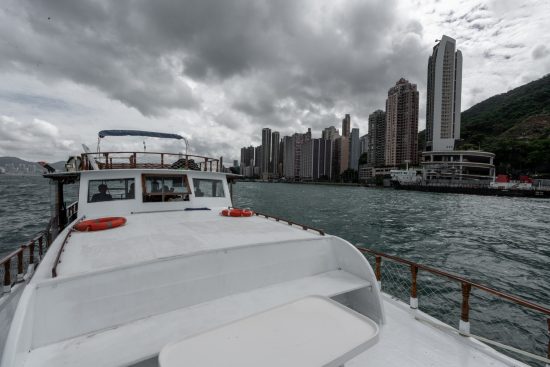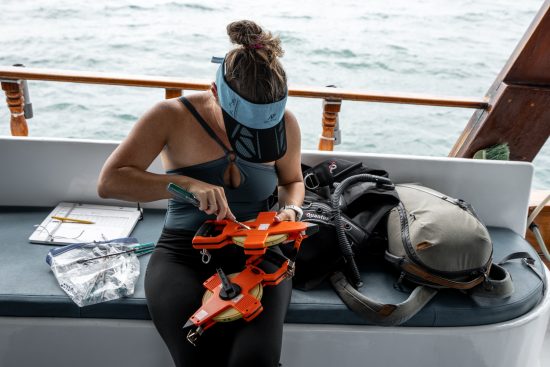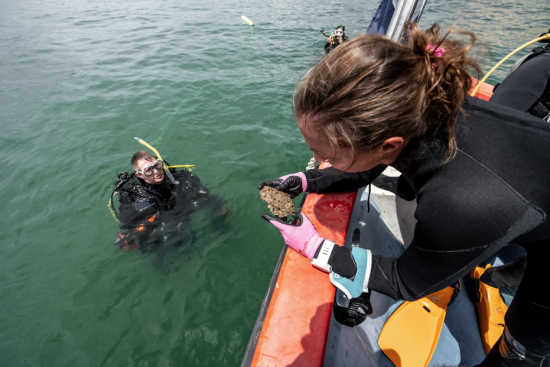





The research team had warned us upfront about the perilous diving experience ahead. One not marked by surreal encounters with majestic marine life or picturesque oceanscapes, but one of a mere 1-3 meters of visibility that would require adept maneuvering through boat traffic amidst unpredictable water surges. Eager yet patient, we awaited the call to meet at the Central docks. But first, the extreme rainstorms needed to pass.
During our time in Hong Kong, we had the misfortune of experiencing what they call “black rain,” marking the city's heaviest rainfall in 140 years. Our plans to dive unidentified sunken ships and explore remote islands in search of pirate treasure were halted.
One harsh reality of our long-term quest to explore consciously is accepting the unpredictable weather, as not every day on expedition is going to be a perfect one. In Hong Kong, we were unequivocally at nature’s mercy. Despite this, The Nature Conservancy’s (TNC) oyster survey proceeded—alongside The Explorers Club Hong Kong Chapter and the Swire Institute of Marine Science of the University of Hong Kong—as the work to prove oyster’s ecological importance had never been more critical.
So, rain or shine, we were going diving for oysters.
The Pearl River Delta, a region once characterized by its thriving populations of reef-building bivalves like oysters and mussels, has been significantly depleted. This is a major issue given the pivotal role they play by acting as natural water filters, improving water quality by removing pollutants and excess nutrients. Additionally, they provide essential habitat for a variety of marine life, support biodiversity, and help stabilize shorelines against erosion, making them vital for the ecological health and resilience of urban coastal ecosystems.
A gap analysis conducted by TNC revealed a concerning disparity. While terrestrial conservation efforts have resulted in 40% of Hong Kong’s land receiving designation as protected green spaces, its marine environments, particularly estuaries and shellfish reefs, are underserved—despite including some of the most endangered habitats on earth.
TNC’s realization of this gap ignited an extensive pilot program study across “eco-regions” in Hong Kong to uncover what sits beneath the surface. This team of researchers were eager to find out the extent of the damage done to shellfish reefs, and the potential for restoration.
Historically, oyster beds were a cornerstone of the local economy and culture. From the 19th to 20th centuries, Hong Kong was known for its booming lime industry, fueled by calcium carbonate extracted from these abundant shells. The lime produced was pivotal in various sectors, including construction and agriculture. However, the extensive dredging activities, as well as rapid urban expansion, led to the decimation of native shellfish reefs.
While oysters have been long appreciated for extraction, their ecological significance has been overlooked for years. Oyster reefs are often degraded or destroyed without adequate scientific surveys, as their conservation hasn’t been prioritized. However, TNC has identified a troubling baseline shift in the health and population of these vital marine organisms, raising alarms about the future health of Hong Kong’s waters.
Daniel Pauly, a French marine biologist, introduced the concept of a "baseline shift." It refers to a shift in the perceived norms of the natural environment's state, stemming from limited historical data or a lack of first-hand knowledge of previous conditions. This perception leads to an underestimation of environmental degradation and biodiversity loss over time, as each generation adapts to a new, diminished “normal.”
Many have become accustomed to Hong Kong’s low visibility and lacking marine life, mistaking the current conditions as normal. TNC’s driving goal with the oyster project is to correct this misunderstanding by unveiling the waters’ historical ecology, and contrasting it with the present state. The continuous shifting of baselines has clouded our perception, making us strangers to the pristine condition of our own natural habitats.
Armed with findings and the tools derived from TNC’s research, future generations will be equipped to not only understand but also to reclaim and surpass the current ecological baseline.
Every piece of data collected and every oyster bed mapped is a step towards a future where the vibrant, rich waters of Hong Kong are not just a part of history, but a thriving reality. The long-term goal is that this work will inspire action, inciting the next generation to do the work necessary to restore the little patches of oyster reefs left to their full potential.
A key component of TNC’s study involved identifying "reference ecosystems" to serve as benchmarks for restoration. These models, characterized by their natural, functional conditions, offer measurable criteria for evaluating the progress of restoration activities. They guide efforts to restore degraded ecosystems, aiming for a revival of their structure, function and diversity to align with the area's natural conditions. Even in a highly degraded state, a reference ecosystem provides insights into potential large-scale restoration and the surviving elements that can be rebuilt and nurtured.
While in Hong Kong, we embedded into the TNC team to visit these reference ecosystems to aid in the collection of oysters for analyzing. Going out on their large research vessel, we were to integrate onto the team, act as support for the scientists and put our dive skills to use. The research included using a 30-meter (100-foot) measuring line and strategically placed quadrants every 3 meters (10 feet) to collect oyster samples. Each sample was photographed, measured and then categorized based on the line and quadrant locations.
A select few, representing the day's most biodiverse activity, were preserved for in-depth laboratory analysis—while the rest went back to the sea. This systematic approach, repeated over successive days, weeks and months, fed data into an oyster database, cataloging the final evidence.
Due to unprecedented torrential rain, the visibility was reduced to less than 1 meter (3 feet) on every one of our dives. My diving partner was the scientist leading the project, Dr. Bayden Russell, Associate Director at the Swire Institute of Marine Science of the University of Hong Kong. And it was his tank I was holding on to with every descent, trying not to lose my buddy or mess up the single job that I had underwater. He was tasked with assessing the reef areas and directing the teams on where to commence sample collection. And my job was to make sure he was safe throughout the process.
For our team, adapting to the limited underwater visibility was challenging. But for the adept divers that call Hong Kong home, they maneuvered the sites with ease. With all the dive teams being seasoned, Bayden was the only one to have dove on Lantau Island, which was where our survey work was taking place. This wasn’t surprising as the visibility was low, but what we were finding beneath the surface was exciting! When each dive team made it back to the surface, they presented bags brimming with oysters of varying sizes.
Bayden was optimistic as he examined our oyster samples at the surface after each dive.
He noted the bivalves’ ability to survive in poor water quality, but highlighted the threat of increased water temperatures. Higher temperatures ultimately affect their physiology, spawning patterns and even creates issues with substrates—or the surfaces to which the shellfish attach.
The foundation of this restoration, in fact, lies in the substrate, as young shellfish especially rely on hard surfaces for attachment and survival. Historically, oyster reefs, composed of generations of oyster shells stacked upon each other, provided this essential substrate. However, disturbances to these structures threaten the shellfish’s habitat and, by extension, their survival.
Another critical member of the team shared a similar optimistic view. The Conservation Program Manager with TNC, Marine Thomas, specializes in estuary conservation and habitat restoration, particularly where rivers converge with the sea. Her work centers on harnessing nature’s innate power to mitigate the impacts of climate change, aiming to bolster Hong Kong's resilience against evolving environmental challenges. “We're debunking the notion that there’s nothing left worth conserving in these waters around Lantau Island,” she said. “We have tangible proof of the diverse life that still thrives here, showcasing the potential for restoration.”
Back on the research vessel, Bayden and Marine walked us through how they sort, measure, and document each specimen. Marine elucidated the significance of this seemingly tedious process, rehashing the core objective of this study: to quantify the existing biodiversity here to inspire future restoration action.
This was a first-of-its-kind effort, having never been done before in Hong Kong.
Real-time efforts like Marine and Bayden’s embody the critical shift needed in our professional and personal endeavors. The urgency isn’t grounded in the possibility of restoration—that’s the easy part to identify and highlight. We know there are ways to restore the blue planet. However, getting people to take the necessary actions to make that happen is the hard part.
This study made it very clear that the planet is resilient and adaptive, having endured mass extinctions, renewing itself in the wake of natural climate variations. Humans, however, may not demonstrate such adaptability to the rapidly evolving environmental challenges. As Marine put it, “it isn’t the earth’s survival at stake, it's ours.”
With the surveying aspect of the study coming to a close, Marine and Bayden acknowledged that there’s a long road ahead of them. Moving from conducting research to shifting human behavior is the never-ending pursuit of many in the field. Shifting perceptions, changing mindsets and mobilizing action is what this research team hopes they can achieve, especially when speaking with the rising generations inheriting a planet in decline.
Seeing was believing for us. Getting a close look at the oyster reefs still intact had us feeling hopeful as we left Hong Kong. Upon our departure, the call to action is clear: we must work collectively to restore our natural ecosystems to their original state. This responsibility extends from the most remote corners of the earth to our busiest urban centers. Restoration is not confined by geography; it's a universal mission that can happen anywhere. It's time for each of us to consider how we can actively contribute to this vital cause, on the edges of earth and right in our own backyards.
 Andi
Andi 18th April 2024
18th April 2024